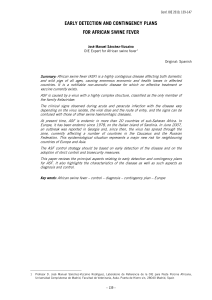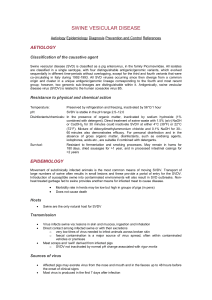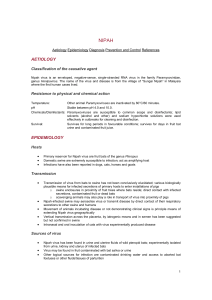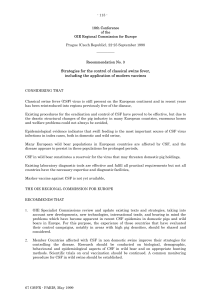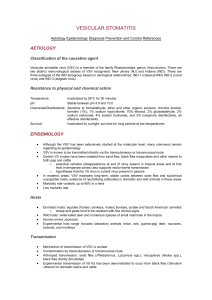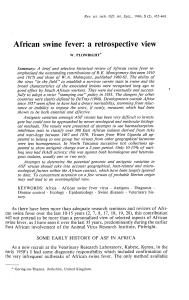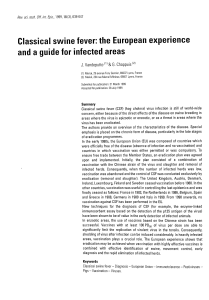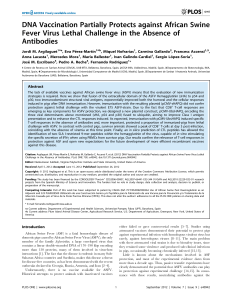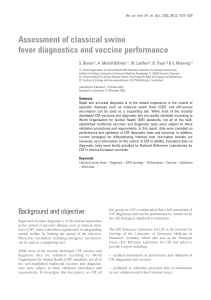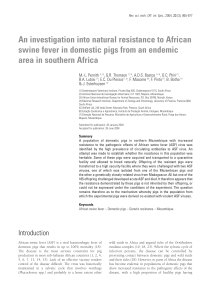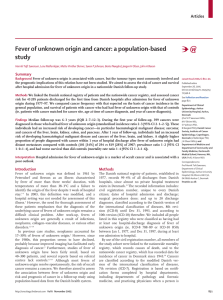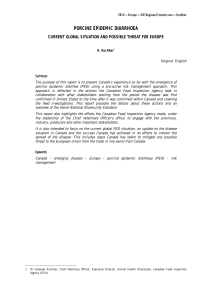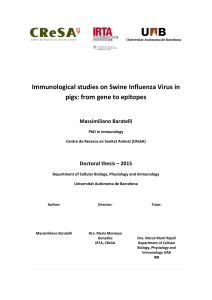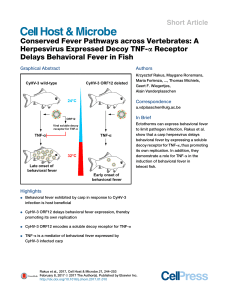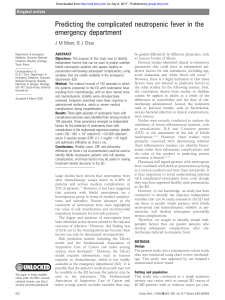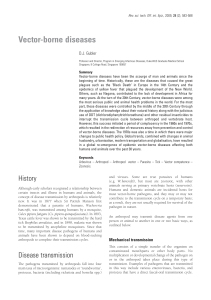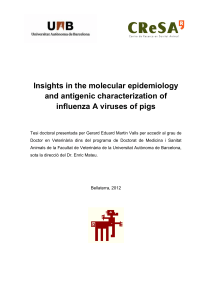D11831.PDF
publicité
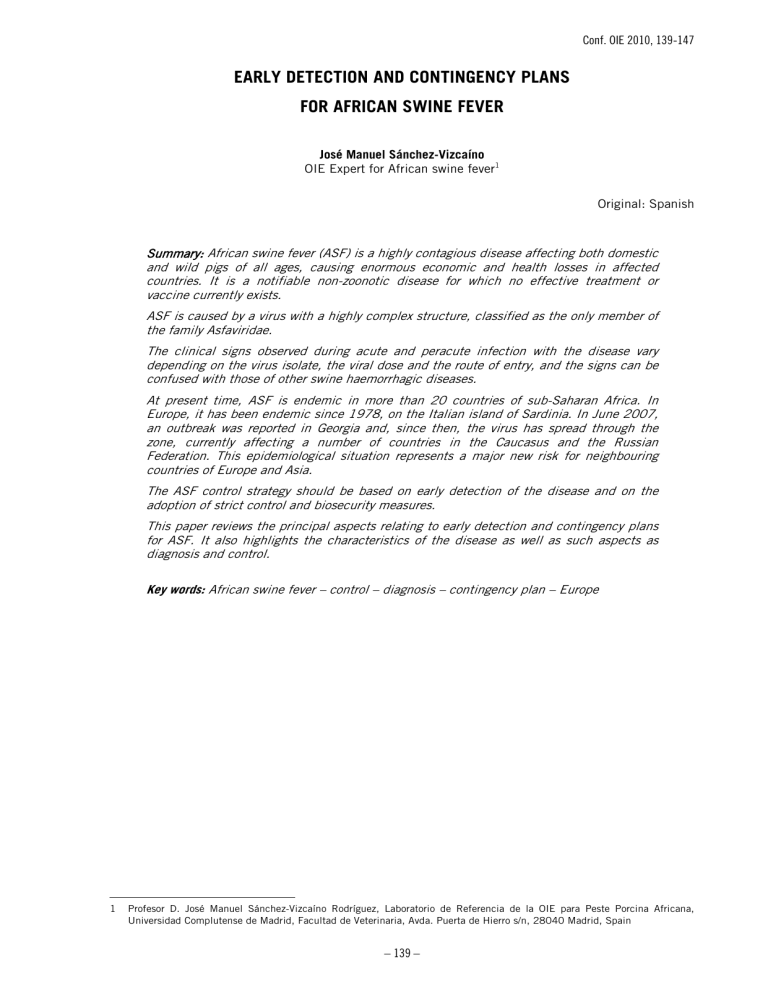
Conf. OIE 2010, 139-147 EARLY DETECTION AND CONTINGENCY PLANS FOR AFRICAN SWINE FEVER José Manuel Sánchez-Vizcaíno OIE Expert for African swine fever1 Original: Spanish Summary: African swine fever (ASF) is a highly contagious disease affecting both domestic and wild pigs of all ages, causing enormous economic and health losses in affected countries. It is a notifiable non-zoonotic disease for which no effective treatment or vaccine currently exists. ASF is caused by a virus with a highly complex structure, classified as the only member of the family Asfaviridae. The clinical signs observed during acute and peracute infection with the disease vary depending on the virus isolate, the viral dose and the route of entry, and the signs can be confused with those of other swine haemorrhagic diseases. At present time, ASF is endemic in more than 20 countries of sub-Saharan Africa. In Europe, it has been endemic since 1978, on the Italian island of Sardinia. In June 2007, an outbreak was reported in Georgia and, since then, the virus has spread through the zone, currently affecting a number of countries in the Caucasus and the Russian Federation. This epidemiological situation represents a major new risk for neighbouring countries of Europe and Asia. The ASF control strategy should be based on early detection of the disease and on the adoption of strict control and biosecurity measures. This paper reviews the principal aspects relating to early detection and contingency plans for ASF. It also highlights the characteristics of the disease as well as such aspects as diagnosis and control. Key words: African swine fever – control – diagnosis – contingency plan – Europe 1 Profesor D. José Manuel Sánchez-Vizcaíno Rodríguez, Laboratorio de Referencia de la OIE para Peste Porcina Africana, Universidad Complutense de Madrid, Facultad de Veterinaria, Avda. Puerta de Hierro s/n, 28040 Madrid, Spain – 139 – Conf. OIE 2010, 139-147 1. Introduction African swine fever (ASF) is a highly contagious disease affecting both domestic and wild pigs of all ages, causing enormous economic and health losses in affected countries on account of the high mortality rates observed in its acute form, it great infectivity through the movement of animals and animal products, the heavy costs of ASF control and eradication and the international restrictions imposed. ASF is caused by a virus with a complex structure, classified as the only member of the family Asfaviridae, for which no effective treatment or vaccine currently exists. ASF is a notifiable nonzoonotic disease. In clinical and anatomopathological terms, the acute and peracute forms of African swine fever (as only highly virulent strains of the virus are currently in circulation, acute and peracute forms are the commonest type) are characterised by high fever, high mortality at the onset of infection, haemorrhages of the skin and internal organs (spleen, kidneys, ganglia) and lymphoid tissue destruction (Table 1). Table 1.– Most commonly observed clinical signs and lesions of African swine fever Acute (highly virulent strains) Subacute Chronic (low-virulence strains) Clinical signs Macroscopic lesions - Fever (40-42º C), anorexia, lethargy and recumbency. Pigs huddle together. - Multifocal hyperaemia and haemorrhagic skin lesions, conjunctivitis. Cyanosis of the skin, especially on the extremities (ears, limbs, tail and snout). - Transient constipation followed by diarrhoea. - Ataxia, paralysis and convulsions. - Abortion. - Dyspnoea, coughing and other respiratory disorders (rapid and difficult breathing), usually in the final phase before death. - Early leucopoenia and thrombocytopenia (48– 72 hours) - Reddening of the skin (white-skinned pigs) on the tips of the ears, tail, distal extremities, ventral aspects of the chest and abdomen. - Anorexia, listlessness, cyanosis and incoordination within 24-48 hours before death. - Increased pulse and respiratory rate. - Vomiting, diarrhoea (sometimes bloody) and eye discharges may exist. - In young domestic pigs, the mortality rate often approaches 100%. - Death within 6–13 days, or up to 20 days - Survivors are virus carriers for life. - Pronounced haemorrhages in the gastrohepatic and renal lymph nodes. - Petechial haemorrhages of the renal cortex, also in medulla and pelvis of kidneys. - Congestive splenomegaly. Spleen a characteristic purplish colour. - Severe pulmonary oedema. - Cyanosis and erythema of the skin on all hairless parts (extremities, ears, chest, abdomen and perineum). - Excess of pleural, pericardial and/or peritoneal fluid. - Petechiae in the mucous membranes of the larynx and bladder, and on visceral surfaces of organs. - Oedema in the mesenteric structures of the colon and adjacent to the gall bladder; also the wall of gall bladder. - Clinical course similar to that described for the acute form, but less severe. - Pigs die between 7 and 20 days following infection. - More pronounced vascular lesions in the gastrohepatic and renal lymph nodes. - Pulmonary haemorrhage, oedema less common. - Less pronounced splenic lesions. - Serous to fibrinous pericarditis. - Characterised by a wide variety of clinical signs, arising mainly from secondary bacterial complications, including reproductive and joint alterations: weight loss, irregular peaks of temperature, respiratory signs, necrosis in areas of skin, chronic skin ulcers, arthritis, pericarditis, adhesions of lungs, swelling over joints. - Develops over 2-15 months. - Low mortality (between 2% and 10% of all sick animals). - Abortion - Intense processes of necrosis (skin and oral cavity). - Arthritis. - Focal caseous necrosis and mineralization of the lungs may occur. - Swelling of the lymph nodes. – 140 – Conf. OIE 2010, 139-147 ASF clinical signs and lesions can closely resemble those of other swine haemorrhagic diseases, such as classical swine fever, salmonellosis and erysipelas (Table 2). Table 2.– Differential diagnosis of African swine fever Disease Clinical signs Species affected Shared Differential Lesions Shared Differential Classical swine fever Pigs Fever, depression. Longer clinical Haemorrhages of course than for the skin, kidneys ASF. and lymph nodes. Ulcers of the cecum and colon, marginal spleen infarctions, pale renal parenchyma, nonpurulent meningoencephalitis. Acute salmonellosis (S. cholerasuis) Pigs Fever, abortion. Watery yellow diarrhoea, low morbidity and high mortality. Cyanosis on the tips of the ears, tail, hooves and abdomen; haemorrhages of the renal cortex; splenomegaly. Focal hepatic necrosis; serous or necrotising enterocolitis. Swine erysipelas Pigs Fever. Chronic forms arthritis. Splenomegaly, petechiae in the renal cortex, ganglionic hypertrophy with swelling and haemorrhage. Cutaneous rhomboid urticaria (diamond skin). Arthritis and vegetative endocarditis. Porcine dermatitis and nephropathy syndrome Pigs NA Non-specific, slight hyperthermia; weakness. Reddish-purple blotches on the skin of the extremities, ears, abdomen and perineum. Renal petechiae. Lesions from necrotising vasculitis. Kidneys pale in spite of the petechiae. Aujeszky’s disease Pigs, ruminants, rodents and carnivores. Abortion; cutaneous cyanosis in piglets. Nervous signs. Pneumonia. Necrotic enteritis. Laboratory diagnosis is essential to establish an accurate diagnosis. A large number of highly sensitive, specific and proven diagnostic techniques now exist that enable an etiological and/or serological diagnosis to be made in just a few hours [1]. Currently ASF is endemic in more than 20 countries of sub-Saharan Africa and on the Italian island of Sardinia. In 2007, an outbreak was reported in Georgia, probably originating from southeast Africa, as the virus genotype identified (type II) was circulating in that area. From Georgia, the virus spread to several countries in the Caucasus region and the Russian Federation, creating a high health-risk epidemiological situation. A panel of experts from the European Food Safety Authority (EFSA) recently analysed the current ASF epidemiological situation in the Caucasus region and the possible risk of the virus spreading to other ASF-free zones, including the European Union, as well as the possibility that the currently infected zone could remain endemic. The analysis results indicate a high risk of spread to neighbouring zones. This risk would be moderate for the European Union, and the risk of the zone remaining endemic would also be moderate [2]. Pigs normally contract the African swine fever virus (ASFV) via the oronasal route, although other routes are also possible, such as the cutaneous route (cuts, scratches or abrasions), or the intramuscular, subcutaneous or intravenous route, caused by the bite of soft ticks of the Ornithodoros genus. The incubation period ranges from 3 to 21 days, depending on the isolate and the route of exposure. Primary replication takes place in the monocytes and macrophages of the – 141 – Conf. OIE 2010, 139-147 lymph nodes closest to the virus entry point. The virus spreads via the blood route, associated with the erythrocyte membranes, and/or via the lymphatic route. Viraemia usually starts 2–8 days postinfection and, due to the lack of neutralising antibodies, persists for a long time, even months. As the ASFV spreads to different organs, such as the lymph nodes, bone marrow, spleen, kidney, lungs and liver, secondary replication and the characteristic haemorrhagic lesions occur [3]. The spread of the virus from infected animals can start from the second day post-infection, by means of saliva, eye and nasal discharges, and through aerosol. After a few days, the virus can also be shed via urine, faeces and semen. The principal routes of transmission are: - contact between infected, recovered or asymptomatic animals and susceptible animals; consumption of contaminated products; transport vehicles; contaminated clothing and footwear; slurry; bites from ticks of the Ornithodoros genus; and surgical equipment and/or veterinary establishments. The disease is transmitted primarily by direct contact between an infected or recovered carrier animal and a susceptible animal, or else when pigs are fed with waste from food prepared using contaminated fresh meat from endemically infected countries. Commercial processed products (such as ham or cured pork loin) contain no active virus 140 days after processing of the fresh meat started. The virus is inactivated in heat-treated products. European wild boar are susceptible to ASFV infection, showing clinical signs and mortality similar to those observed in domestic pigs, although wild boar tend to be more resistant than domestic pigs. Aerosol transmission is not important in the spread of ASF. However, the blood of a recently infected pig contains a large ASFV load: 105.3 to 109.3 HAD50 per millilitre [4]. The disease can therefore spread widely as a result of fighting between pigs with bleeding wounds, the presence of bloody diarrhoea or the performance of a post-mortem examination. Throughout the history of ASF, epidemiological evidence has shown that the vast majority of outbreaks that have occurred in ASF-free zones were mainly the result of feeding food waste products from infected pigs to susceptible pigs (Table 3). Table 3.– Primary source of African swine fever outbreaks in various countries Year Country Source Reference 1960 Portugal Imported meat products Neitz, 1963 1978 Brazil Raw waste from an international airport McDaniel, 1986 1978 Malta Raw waste from a sea port McDaniel, 1986 1978 Sardinia Raw waste from a sea port McDaniel, 1986 1980 Cuba Importation of live pigs/pig products McDaniel, 1986 1983 Italy Importation of pig products McDaniel, 1986 Once the infection has become established in a given zone, the movement of infected animals or animal products, contaminated transport vehicles and animal feed made from food waste are the commonest means for maintaining viral circulation, which can increase when wild pigs (wild boar), which are major vectors of ASF, become infected, and where soft ticks of the Ornithodoros genus are present. As there is no effective treatment or vaccine against infection by the ASFV, early detection and the implementation of appropriate contingency plans are the best means for controlling it. – 142 – Conf. OIE 2010, 139-147 2. Early detection of African swine fever Without doubt, early disease detection is the key to maintain animal health and is the most complex facet of effective disease surveillance. The major scientific advances achieved in recent decades have led to laboratory diagnostic methods that are not only highly sensitive and specific, but also quick to perform. Indeed, the great majority of national and international reference laboratories possess techniques for establishing an accurate laboratory diagnosis in just few hours. However, the main challenge at present is the long time it takes to detect the disease in the field, or at least to suspect its occurrence. There have been cases where very well-known diseases, such as foot and mouth disease, classical swine fever or bluetongue, have circulated in a number of countries for several weeks, or even months, without any suspicions being raised or samples being sent to the laboratory for differential diagnosis. In some cases, this was because of the atypical presentation of the disease in countries that had never before been infected and had never considered the possibility of becoming infected. In other cases, it was because the disease occurred in animal species presenting few clinical signs, as well as because of wrong design of surveillance programmes. Indeed, a wide variety of factors can delay the early detection of ASF. They can be grouped as follows: - Lack of awareness or underestimation of the risk of introduction (probability of spread of the agent). - Unfamiliarity with the disease, the differential diagnosis, and the clinical and anatomopathological presentation. - Deficient epidemiological and diagnostic procedures. Lack of preparation of field equipment. Testing of inappropriate samples. Laboratory errors. It is therefore very important to remember that rapid and effective diagnosis relies on limiting the spread, as well as on implementing appropriate measures as quickly as possible, as these factors are critical to the evolution of the disease and the resolution of the problem. It is also important to remember that, in order to make a rapid diagnosis: first, the disease must be suspected in the field; second, appropriate samples must be sent to the laboratory; and, third, the correct control measures must be established. Early disease detection will therefore depend on the right balance between field surveillance, laboratory resources and control measures. To ensure good field surveillance, the top priority is to make veterinarians and livestock producers aware of the risk of the entry of a given disease and of the importance of reporting any suspicions. Therefore the first and most important measure should be to provide private and official veterinarians and livestock producers in the zone with information and training on the existing risk and the main characteristics of the disease. This information should concern mainly the potential routes of entry of the disease, its clinical signs and potential lesions, and the samples that must be sent to the laboratory for establishing the correct diagnosis. Samples of choice to be sent to the laboratory where African swine fever is suspected: - blood with anticoagulant (EDTA); serum; spleen; lung; kidney; lymph nodes. Owing to the wide range of clinical signs and lesions that can be caused by infection with the African swine fever virus, and their similarity to other swine haemorrhagic diseases, laboratory diagnosis is essential for ASF. In risk zones, any death of a pig with clinical signs of haemorrhagic fever must be investigated, bearing in mind that a differential diagnosis (see Table 2) must be made with the following diseases: - classical swine fever; salmonellosis; erysipelas; acute pasteurellosis; streptococcal infection; Aujeszky’s disease; - leptospirosis; circovirus infection: porcine dermatitis and nephropathy syndrome (PDNS) and postweaning multisystemic wasting syndrome (PMWS); coumarin poisoning. – 143 – Conf. OIE 2010, 139-147 The second key requirement is to have appropriate laboratory diagnostic methods. At present, a large number of methods are available for carrying out different types of diagnosis: virological (detection of the virus or viral proteins), molecular (detection of viral DNA) and serological (detection of antibodies) (Table 4). The Manual of Diagnostic Tests and Vaccines for Terrestrial Animals details the procedures to be followed [5]. Table 4.– ASF laboratory diagnosis methods Virus detection Characteristics The ASF virus is isolated from primary porcine macrophage cultures. ASFV is capable of infecting and replicating itself naturally in peripheral blood leukocyte cultures from pigs where, in addition to producing a cytopathic effect in the infected macrophages, it causes a characteristic effect of haemadsorption (HAD) prior to cell lysis. Under the microscope, it appears as rosettes of erythrocytes around the leukocytes. The haemadsorption technique is still the most sensitive and specific method of identifying ASFV, as none of Haemadsorption test the other swine viruses produce this effect. Despite the fact that haemadsorption is laborious to use and not as rapid as other diagnostic methods (with results taking 5–10 days), it is the technique of choice compared with other faster diagnostic methods, although it is important to bear in mind that some ASFV strains are non-haemadsorbing. In such cases, additional analyses of the cell sediment must be made, using the polymerase chain reaction technique or the fluorescent antibody test to confirm the presence of the virus. The fluorescent antibody technique is based on the detection of viral antigens by staining cryostat sections or impression smears of tissues with fluorescein isothiocyanate (FITC)conjugated anti-ASFV immunoglobulin. It is a very simple, rapid and sensitive method that can also be used on cell cultures infected with macerates of organs or tissues from suspect pigs. Under the microscope, infected cells display Direct cytoplasmic inclusions that emit intense fluorescence. When immunofluorescence the infection is advanced, the specific fluorescence can technique appear granular. Where the infection is older than 10 days and antibodies have formed, these may block the conjugate and produce a false-negative result. For this reason, if FAT is the chosen technique, it must be used in parallel with an antibody detection test (indirect fluorescent antibody test, enzyme-linked immunosorbent assay or the immunoblotting test). HAD is a technique currently used only in a few reference laboratories. HAD takes between 3 and 10 days to complete. FAT is a technique recommended only when polymerase chain reaction is unavailable or when there is insufficient experience with using PCR. It must not be forgotten that a negative result must be confirmed and it is recommended to carry out an antibody detection test in parallel. FAT takes 75 minutes to complete. Polymerase chain reaction (PCR) PCR is a highly sensitive and specific technique that confirms the presence of the virus by amplifying the viral DNA present in the sample. The PCR technique uses primers from a highly conserved region of the genome to detect a wide range of known ASFV isolates, including haemadsorbing and nonhaemadsorbing strains. It is currently used by reference laboratories for the virological diagnosis and confirmation of ASF. It can be used in both tissue samples and serum samples from animals with clinical signs, as it produces prolonged viraemia. The PCR technique can therefore be used to detect the virus in blood starting from the second day of infection and up to a period of weeks. PCR is currently the most commonly used technique for etiological diagnosis but it calls for thorough training. PCR takes 5 to 6 hours to complete. Enzyme-linked immunosorbent assay (ELISA) Techniques such as sandwich ELISA or immunodot blot have also been adapted for ASF, but are less commonly used because, even though they are extremely sensitive in the early phases of infection, this sensitivity diminishes drastically as from 9–10 days post-infection, as they may be blocked by antibodies, as described earlier in relation to FAT. ELISA is not used routinely. It takes 3 hours to complete. – 144 – Conf. OIE 2010, 139-147 Antibody detection Characteristics Indirect fluorescent antibody test (IFA) IFA is a rapid technique with good sensitivity and specificity, where the specific antibodies present in the serum or exudates are made to react on a cell mat infected with the ASF virus. The reaction is displayed by adding iodinated protein A or a second fluorescein-labelled porcine anti-IgG antibody. Where positive samples are present on the cell mat, fluorescences appear at certain points close to the nucleus, which are the ASFV replication centres. IFA is little used at present. There are no commercial reagents. It takes 2 hours to complete. ELISA ELISA is the methodology used to carry out large-scale epizootiological and control studies. The ELISA technique currently used employs a soluble antigen containing most of the ASF virus proteins. This method is highly sensitive and specific, as well as being fast, easy and inexpensive. Recently, new ELISAs have been developed with noninfectious reagents, using the recombinant proteins p32, p54 and pp62 as viral antigens. These ELISAs are equally or more sensitive and specific than the current technique for analysing poorly conserved sera. ELISA is currently the most commonly used technique, for which commercial diagnostic kits are also available. It takes 2 hours to complete. Immunoblotting is an immunoenzymatic technique whereby ASF viral proteins are transferred to nitrocellulose filters serving as the antigen strips on which the suspect serum is made to react, using protein A-peroxidase to detect specific antibodies. The immunoblotting technique is used to determine the reactivity of the antibodies present in the serum to different proteins induced specifically by the African Immunoblotting test swine fever virus. This characteristic, together with its high sensitivity and objectivity, makes immunoblotting the ideal serological diagnosis technique for confirming ASF. No commercial diagnostic kits are available and the reagents are produced in some European Union and OIE Reference Laboratories. Immunoblotting is an excellent technique for serological confirmation in cases of doubt. It takes 3 hours to complete. Table 4 summarises the techniques currently used to diagnose ASF, their advantages and drawbacks and their most recommended use. In general it is recommended to use more than one diagnostic technique for the initial diagnosis. The techniques most commonly used at present are PCR followed by sequencing, or else the indirect ELISA or the immunoblotting test. In cases where PCR is not possible, the fluorescent antibody test with a parallel antibody test can be used. In any case, parallel tests must always be conducted to detect both the virus and the antibodies. The ASF virus is highly antigenic and produces a large quantity of non-neutralising antibodies that can be detected from between 7 and 10 days post infection and can persist for months. In addition, as no vaccine exists, the presence of antibodies is always a sign of infection. Lastly, it is important to remember that when techniques such as the fluorescent antibody test or direct ELISA are used to detect viral antigens, the presence of the animal’s antibodies can block the union of the conjugate and produce false-negative results. Furthermore, using a combination of methods for detecting antigens and antibodies provides a pointer as to how long-standing the infection is because, when antigens but no antibodies are detected, it may indicate an early infection less than 10–12 days old. The identification of antibodies can also identify carrier animals, common in long-standing ASF infections. 3. Contingency plans Contingency plans are essential and must be prepared in advance of any outbreak. All countries should therefore possess a contingency plan for African swine fever, in particular the countries currently at the greatest risk. A contingency plan for the control of ASF entails the stamping out and disposal of all infected, suspect and contact animals. For this reason, a legally supported contingency fund to compensate – 145 – Conf. OIE 2010, 139-147 producers for the slaughter of their pigs is a crucial control measure for encouraging notification and guaranteeing the success of the control programme. The contingency plan should incorporate a clearly written manual that includes all the actions to be taken from the time of the suspicion until the end of the outbreak. Contingency plans must be geared to each country’s epidemiological, sanitary, production and infrastructure conditions and must, of course, comply with current OIE standards and recommendations. Table 5 summarises OIE and European provisions concerning ASF prevention and control plans. Table 5.– Standards, recommendations and other provisions on ASF prevention and control plans Terrestrial Animal Health Code 2010, World Organisation for Animal Health International standards (OIE), Chapter 15.1. Manual of Diagnostic Tests and Vaccines for Terrestrial Animals, World Organisation for Animal Health (OIE), Chapter 2.1.12. Community (European Union) Commission Decision 2003/422/EC of 26 May approving an African swine fever diagnostic manual Council Directive 2002/60/EC of 27 June laying down specific provisions for the control of African swine fever and amending Directive 92/119/EEC as regards Teschen disease and African swine fever A contingency plan must include at least three general sections that provide as much information as possible on the following aspects: i. Administrative structure in the zone or country: Veterinary Service, diagnostic laboratory, current legislation. ii. Livestock production structure: census, number of establishments and their location, movements, wild population, etc. iii. Characteristics of the disease: technical fact sheet, risk factors, susceptible animals and/or vectors, clinical course and lesions, routes of entry and spread, incubation period, samples to be sent to the laboratory, diagnostic methods, disinfectants to be used, etc. More specific information should also be provided on the course of action to be taken in a zone with a suspected or confirmed outbreak, which should include at least the following data: - notification system, inspection of the suspect establishment (clinical and epidemiological observation), dispatch of samples to the laboratory; zoning of the affected area; ban on animal movements in the zone, course of action in adjacent establishments, movement controls, epidemiological surveillance; laboratory confirmation; methods for the slaughter of animals; procedure for the destruction of carcasses; depopulation; cleaning and disinfection of the establishment and transport vehicles; serological controls in the zone and adjacent zones to ascertain the possible spread of the outbreak; study of wild boar and/or vectors; use of sentinel animals to confirm that the virus has been eliminated from affected establishments that were subjected to cleanout; repopulation. – 146 – Conf. OIE 2010, 139-147 It is also recommended to draw up a practical manual that details the actions described above, which would be summarised under the following headings: - - Actions to be taken following a reported suspicion. Inspection of the suspect establishment, concrete biosecurity measures to be taken in the suspect establishment and adjacent establishments. Clinical and anatomopathological examination. What needs to be done and observed. Taking samples and dispatching them to the laboratory, together with information on the source of the sample. Type of sample to be collected; laboratories authorised to diagnose ASF. Model epidemiological survey (concrete questions on the entry of animals, semen, visitors), as well as a record and date of movements into and out of the establishment. Specific details of the slaughter method that should be used. Procedure for the disposal of carcasses. Cleaning and disinfection methods. Zoning: definition of the focal zone, perifocal zone, buffer zone and sampling zone (serological controls). Detection of vectors and method for tick capture. Criteria for the use of sentinel animals. References [1] Arias M., Sánchez-Vizcaíno J.M. (2002).– African swine fever. In: Trends in emerging viral infections of swine. A. Morilla, K.J. Yoon & J.J. Zimmerman (eds).119–124. Ames, IA: Iowa State Press. ISBN: 978-08138-0383-8 [2] EFSA. European Food Safety Authority. 2010.– Scientific opinion on African Swine Fever. EFSA Journal 2010; 8(3):1556 [149 pp.]. doi:10.2903/j.efsa.2010.1556. www.efsa.europa.eu [3] Sánchez-Vizcaíno J.M. (2006).– African swine fever. In: Diseases of swine. 9th edition. pp 291-298. Ed. B. Straw, S. D’Allaire, W. Mengeling, D. Taylor. Iowa State University. USA. ISBN 10-0-8138-1703-X [4] McVicar J.W. (1984).– Quantitative aspects of transmission of African swine fever virus. Am J Vet Res 45:1535-1541. [5] OIE (World Organisation for Animal Health) (2008).– Manual of Diagnostic Tests and Vaccines for Terrestrial Animals, 6th edition. OIE, Paris. _____________ – 147 –
